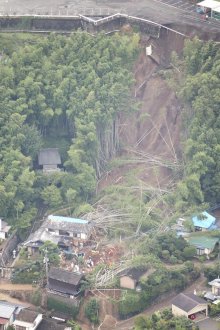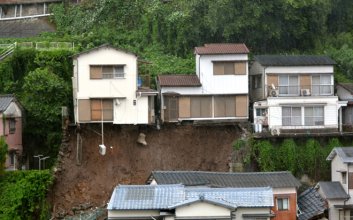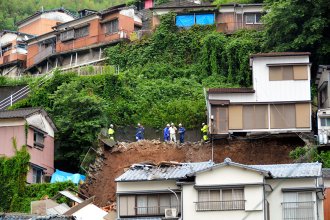A house hit by a landslide in Kita Ward, Kumamoto, is seen in a photo taken from a Yomiuri Shimbun helicopter on Tuesday morning:

KUMAMOTO — Five people died and one was missing in Kumamoto Prefecture as record-breaking torrential rains hit the Kyushu region and surrounding areas from Monday night to Tuesday morning.
Caused by an increasingly active seasonal rain front, the rain triggered landslides and other disasters in the prefecture, which recently suffered severe damage from the Kumamoto Earthquake.
The Japan Meteorological Agency warned that torrential rains were also predicted to hit eastern parts of the country later on Tuesday, and called for people in the regions to be on alert for landslides and swollen rivers.
According to the JMA, cumulonimbus clouds grew one after another and heavy torrential rains fell in certain areas. The highest rainfall in one hour was 150 millimeters recorded in Kosa, Kumamoto Prefecture, the fourth-highest on record for the nation.
Total rainfall as of 6 a.m. Tuesday was 537.5 millimeters in Ebino, Miyazaki Prefecture; 424.5 millimeters in Minami-Aso, Kumamoto Prefecture; and 344 millimeters in Yamae, Kumamoto Prefecture.
According to the Kumamoto prefectural government, 92-year-old Tameki Iwaya was confirmed dead at a hospital after his house was hit by a landslide in the Oyanomachi-Noboritate district in Kami-Amakusa on Monday night.
Shortly after 12 a.m. Tuesday, Osamu Soga, 79, was found lying in a flooded parking lot in the Iwashita district in Kosa. He was later confirmed dead.
In Uto, a landslide hit a residential area, killing Takamichi Nakaguchi, 66.
In Kita Ward, Kumamoto, Tsuneko Hashitani, 85, died when she was engulfed in a landslide. Her husband, Nobuto, 87, was also confirmed dead.
Fourteen people from 11 households were stranded in the Tateno district of Minami-Aso, as landslides blocked National Highway Route 57 and other roads. Many residents had already evacuated to places outside of the village because tap water supplies were cut due to the Kumamoto Earthquake. Local authorities said the safety of all the villagers had been confirmed.
The JMA said there will also be heavy rainfall in eastern Japan.
Rainfall for the 24 hours up to Wednesday morning was predicted to be 150 millimeters in the southern Kyushu region, 120 millimeters in the Tokai region, 100 millimeters in the northern Kyushu, Kinki and Kanto-Koshin regions, and 80 millimeters in the Chugoku and Shikoku regions.
On Tuesday morning, a meeting about disaster-control measures was held with concerned ministries and agencies in the Cabinet Office. Taro Kono, minister of state for disaster management, said at the meeting, “I want to make sure concerned ministries and agencies share information about damage and predicted weather conditions. The government intends to take all possible actions to prevent further damage.”
According to the JMA, the record-breaking torrential rains were caused by several conditions that tend to readily form cumulonimbus clouds.
First, a large volume of moisture vapor over the sea, which can form rain clouds, flowed into areas surrounding the Kyushu region. Due to the effects of a Pacific high-pressure system expanding along the southern cost of the Japanese archipelago, and the effects of westerlies flowing along the seasonal rain front, warm and humid air masses entered the Kyushu region from the southwest and west simultaneously.
At high altitude, two low-pressure systems moved from west to east, and a pressure trough between them, which causes ascending air currents, approached the Kyushu region.
As a result, huge volumes of moisture vapor around the Kyushu region were brought into the high altitude area and many cumulonimbus clouds formed.
Prof. Hisashi Nakamura of the University of Tokyo said that in this instance a squall line, in which cumulonimbus clouds form one after another and line up in a belt, was created over the sea.
The squall line entered Kumamoto Prefecture and other places in the Kyushu region, Nakamura said.
Squall lines also caused heavy rainfall in September last year in the Kanto and Tohoku regions. At that time, a riverbank along the Kinugawa river collapsed.

KUMAMOTO — Five people died and one was missing in Kumamoto Prefecture as record-breaking torrential rains hit the Kyushu region and surrounding areas from Monday night to Tuesday morning.
Caused by an increasingly active seasonal rain front, the rain triggered landslides and other disasters in the prefecture, which recently suffered severe damage from the Kumamoto Earthquake.
The Japan Meteorological Agency warned that torrential rains were also predicted to hit eastern parts of the country later on Tuesday, and called for people in the regions to be on alert for landslides and swollen rivers.
According to the JMA, cumulonimbus clouds grew one after another and heavy torrential rains fell in certain areas. The highest rainfall in one hour was 150 millimeters recorded in Kosa, Kumamoto Prefecture, the fourth-highest on record for the nation.
Total rainfall as of 6 a.m. Tuesday was 537.5 millimeters in Ebino, Miyazaki Prefecture; 424.5 millimeters in Minami-Aso, Kumamoto Prefecture; and 344 millimeters in Yamae, Kumamoto Prefecture.
According to the Kumamoto prefectural government, 92-year-old Tameki Iwaya was confirmed dead at a hospital after his house was hit by a landslide in the Oyanomachi-Noboritate district in Kami-Amakusa on Monday night.
Shortly after 12 a.m. Tuesday, Osamu Soga, 79, was found lying in a flooded parking lot in the Iwashita district in Kosa. He was later confirmed dead.
In Uto, a landslide hit a residential area, killing Takamichi Nakaguchi, 66.
In Kita Ward, Kumamoto, Tsuneko Hashitani, 85, died when she was engulfed in a landslide. Her husband, Nobuto, 87, was also confirmed dead.
Fourteen people from 11 households were stranded in the Tateno district of Minami-Aso, as landslides blocked National Highway Route 57 and other roads. Many residents had already evacuated to places outside of the village because tap water supplies were cut due to the Kumamoto Earthquake. Local authorities said the safety of all the villagers had been confirmed.
The JMA said there will also be heavy rainfall in eastern Japan.
Rainfall for the 24 hours up to Wednesday morning was predicted to be 150 millimeters in the southern Kyushu region, 120 millimeters in the Tokai region, 100 millimeters in the northern Kyushu, Kinki and Kanto-Koshin regions, and 80 millimeters in the Chugoku and Shikoku regions.
On Tuesday morning, a meeting about disaster-control measures was held with concerned ministries and agencies in the Cabinet Office. Taro Kono, minister of state for disaster management, said at the meeting, “I want to make sure concerned ministries and agencies share information about damage and predicted weather conditions. The government intends to take all possible actions to prevent further damage.”
According to the JMA, the record-breaking torrential rains were caused by several conditions that tend to readily form cumulonimbus clouds.
First, a large volume of moisture vapor over the sea, which can form rain clouds, flowed into areas surrounding the Kyushu region. Due to the effects of a Pacific high-pressure system expanding along the southern cost of the Japanese archipelago, and the effects of westerlies flowing along the seasonal rain front, warm and humid air masses entered the Kyushu region from the southwest and west simultaneously.
At high altitude, two low-pressure systems moved from west to east, and a pressure trough between them, which causes ascending air currents, approached the Kyushu region.
As a result, huge volumes of moisture vapor around the Kyushu region were brought into the high altitude area and many cumulonimbus clouds formed.
Prof. Hisashi Nakamura of the University of Tokyo said that in this instance a squall line, in which cumulonimbus clouds form one after another and line up in a belt, was created over the sea.
The squall line entered Kumamoto Prefecture and other places in the Kyushu region, Nakamura said.
Squall lines also caused heavy rainfall in September last year in the Kanto and Tohoku regions. At that time, a riverbank along the Kinugawa river collapsed.




